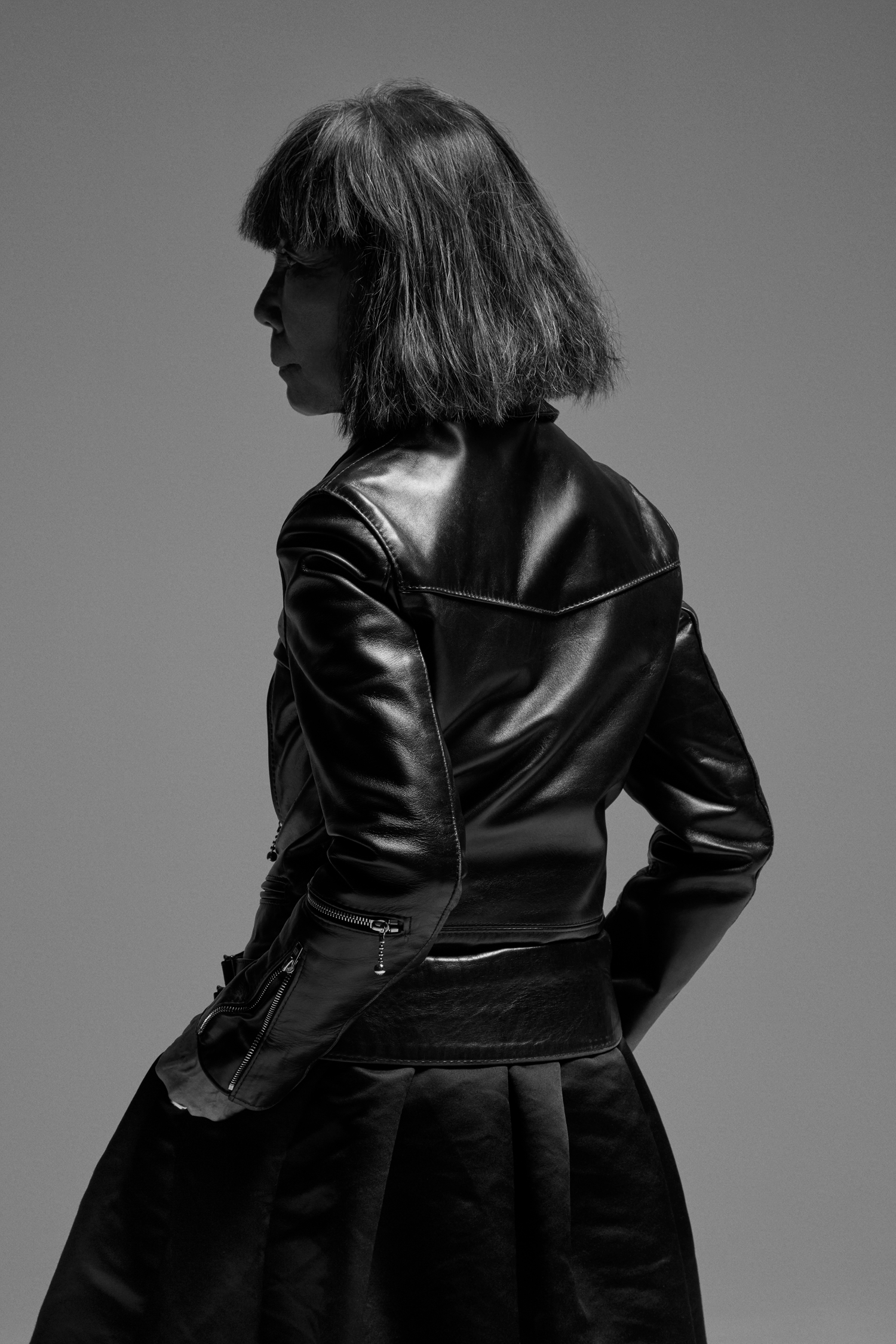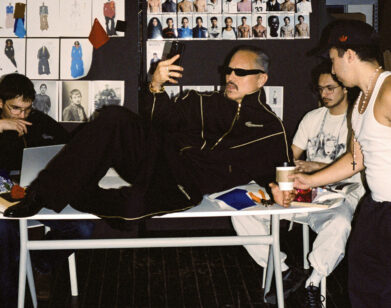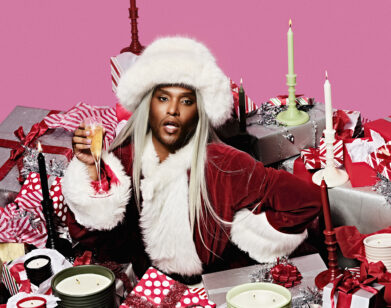Future Folklore: An Unedited E-Mail Correspondence Between Rei Kawakubo and Björk

All clothing and accessories by Comme des Garçons.
“Could this interview be called ‘Future Folklore,’ or something with the word ‘folklore’ in it?” That was Björk‘s one request before we published an entirely unedited electronic back-and-forth between Comme des Garçons and Dover Street Market founder Rei Kawakubo and the musician and producer Björk, quite likely the two most fiercely creative people on the planet. We obliged her.
_ _ _
BJÖRK: dearest rei,
i am so honoured to be having this conversation ! you are one of the people i look most up to and i am thrilled that this is happening i was thinking where the two of our interests overlap and started for some reason thinking about roots, folklore or the lack of it ………….,you mention in an interview from 1982 that you wanted to get away from the folkloric influences in japanese fashion. i find that very interesting … i have always felt that japanese and icelandic cultures have in common that when buddhism and christianity arrived, it was done with less violence than in other countries and the door to the previous more “pagan” faiths like shinto and nordic mythology ( þór, freyja, óðinn .. ) was kept open. so when “civilization” happened there was still full access to nature. so there is less guilt floating around between the 2. in iceland, technology and nature are not necessarily enemies, they can coexist… i’m curious how you feel about mythology, nature and folklore in your work now.
REI KAWAKUBO: I don’t feel I have ever been influenced in any concrete way by nature or the natural world as such. Nature is strong as it is. In the same way as nature is strong by its very existence, without having to be “designed,” I try to make strong clothes. But this is an extremely difficult thing to do. I have never made anything consciously thinking about Japan, either. I just spend every day looking for something new, something that goes beyond any cultural references and which has nothing to do with where I am from
BJÖRK: i understand ……. i feel like i have been running away from cliche national emblems: the icelandic sweater, viking hats and elves for all my life ha ha ha ha. and to be honest the strongest way i am influenced by nature in iceland is actually not in the romantic flowery way but with the amount of space the landscape in iceland has. there are almost no plants, people and a not a lot of animals, at least not dangerous ones or any that block your view. when i travel to other countries, especially cities, i get very claustrophobic and can’t do my normal hikes with singing. i have noticed that a lot of musicians and composers seem to end in rural areas or in a house far away from everything hermit style where there is no sound pollution so they have a blank audio canvas to write in. i have also noticed this seems to not affect people who work in visuals ( art , fashion and so on ) as much. maybe it is something very simple how the ears and eyes work differently? sound fills a whole room in a more oceanic way but you only see a painting or a sculpture if you turn towards it? so it often becomes more of an “idea”? these are all just speculations ….. but how do you feel about space, work space, or space to live in? how much and what kinda space do you need?

All clothing and accessories by Comme des Garçons.
KAWAKUBO: Thank you for this question. i found it very interesting to think about the difference of how artists work in spaces and how it relates to their work. How musicians hear all around them and how visual artists have to use their eyes. They cant hear their work. I wish i could sometimes hear my work. In a way i do. i remember doing Six magazine in the eighties, how i wanted to think about the sixth sense, that encompasses all the other five. But now the struggle i have more and more in trying to find something new is i think unrelated to any physical space as such, except the space in my head which is too full up. The space i need is the space where fifty years of experience can be obliterated. But space itself is important. i cannot work or be in an ugly space, where the air doesn’t flow around freely. Also i want to say it seems the visual aspect of your ‘sound’ work, seems very important and integral to the whole thing, how you look, the videos and films. It is all part of a whole. everything matters. Its the same for me. when i am making clothes i cant help thinking and where they going to end up, in what environment, in what context. Is it true that the whole for you is as crucial as each part?
BJÖRK: ha ha ha ha “where fifty years of experience can be obliterated.” i love that!!!! ……. i think perhaps i have learned over the years to be more and more specific when it comes to visual things. i have slowly been translating from the music to what can represent it in images. i have ready now a whole palette of references to share with the visual people i work with throughout each album , usually a very strict colour palette, emotions, textures and timbres …..so i guess you are right ……. and the character of each album is really strong , often stronger than me. i would like to ask you about the characters you often form with your clothes . they are often quite prankster-ish , like you allow women to be tricksters and “folkloric”? i remember how walking into your stores would free me from the typical “civilized” western femme archetype and be more androgyne, creature like. Perhaps it is current folklore or folklore for the future ?
KAWAKUBO: When I’m thinking about making clothes, I don’t think about the wearing of them, or what the image will be when someone wears them. I create at the place where the body or the person is separate from the clothes. They then become clothes as a result of that.

All clothing and accessories by Comme des Garçons.
BJÖRK: that is sublime ! another thing i would love to discuss is how i admire how you run dover street market. i have said this before in the media but would be curious to hear your point of view. perhaps only a matriarch would be so generous in sharing their status and vision for others to grow in their own name …… it is hard to even imagine the big male designers make such an effort to create such an umbrella for others …..
KAWAKUBO: I enjoy the result of clashing together different images, objectives and personalities as well as contrasting styles. I have never worked thinking about the result of anything. Every day—every day—for the past 50 years has simply been the accumulation of all this. It’s not really a choice. The possibility of synergy and accident in the coming together of different creative powers is what is interesting for all parties, but there is nothing conscious,no agenda.
BJÖRK: i admire that answer a lot. i thrive on this energy as well. but i have to say it is quite selfless. and i have to say, as dangerous as dualism of matriarchy and patriarchy is (of course nothing is so black and white ) i have to point out that typically the”mother” feeds on the energy of seeing her children thrive, that is the nourishment she seeks . but the ego of the male artist has through the centuries not given space for his assistants or helpers or coworkers to grow . and rarely we hear of their names. i’m sorry rei to be guilty of simplifying extremely but i risk it in the chance of offering you a deep and a hopefully meaningful compliment which i hope you accept.
KAWAKUBO: Its true that I have always been uncomfortable with compliments, especially in this business. but from you course i humbly thank you, you are genuine artist and it is heartfelt. thank you..words as part of my work have always been little..i like short powerful messages… i don’t like to say too much, especially to journalists. I have never been conscious of how being a woman has affected my work. Of course i don’t like discrimination of any kind, and being a businesswoman in japan has never been easy.. but your point about dualism is interesting.. but i think it goes beyond just man and woman. i think pure creation can thrive best and true freedom finally achieved when all kinds of dualism, left and right, real and unreal, man and woman, etc can be transcended..don’t you think?
BJÖRK: i million percent agree!!!!!
KAWAKUBO: I want to thank you Björk for your amazing deeply thought questions. warmest regards.
Rei
BJÖRK: gratitudes back rei warmthness and endless respect
björk
This article appears in the fall 2019 50th anniversary issue of Interview magazine. Subscribe here.
Model: Jane Kovich at Donna Models.
Hair and Makeup: Abe at Mo Management Office.
Head Looks: Julian D’ys at L’Atelier NYC.
Production: Tatsuroi Iwahara
Photography Assistants: Makoto Nakamori and Ryusei Sugimoto.
Hair Assistant: Kazuya Hirose.






